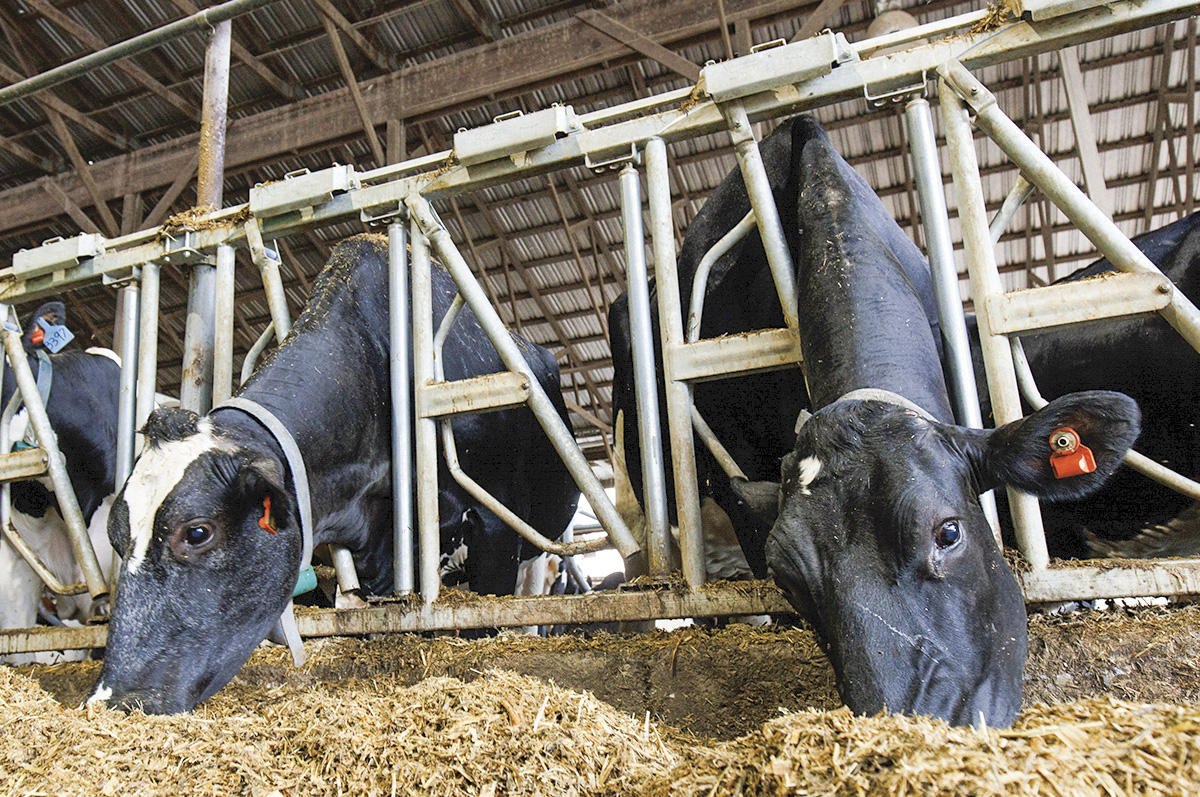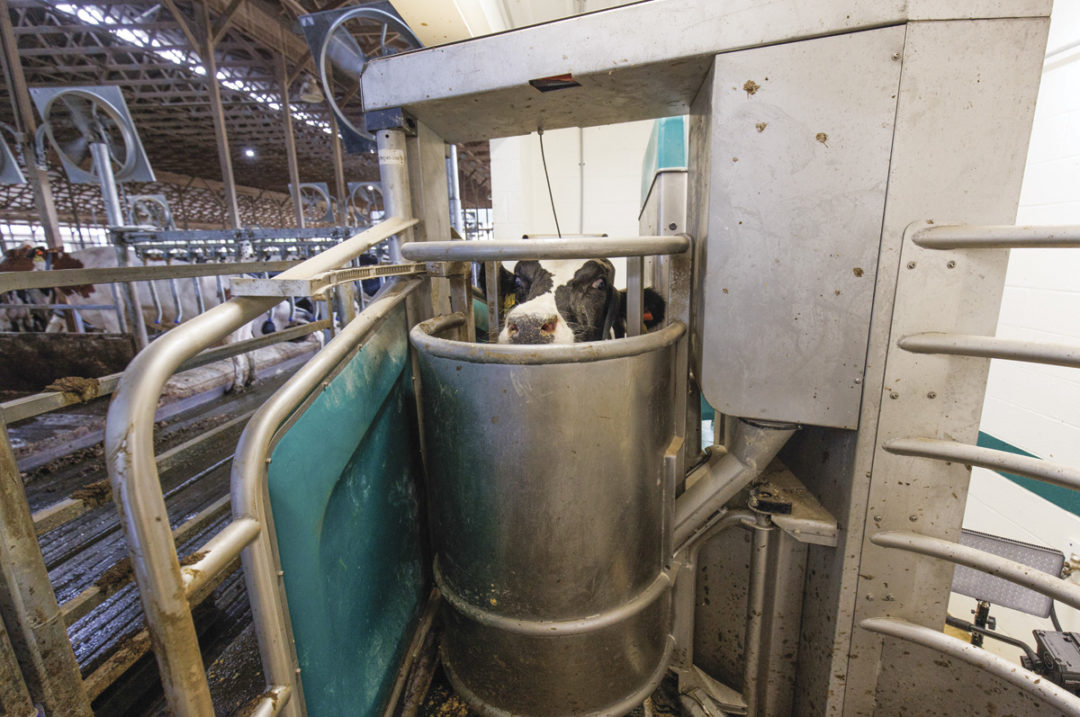To read this article in French, click here.
The transition period is one of the most stressful times of a cow’s life, no matter what type of milking system you use. As a result, a strong start to the transition period can set a cow up for a successful lactation, including increasing milk production and reducing health challenges.
Robotic milking systems provide many advantages to transition cows, from increased milking frequency and access to data to maximizing feed efficiency. Use these feeding and management tips and tricks to give your transition cows a strong start in your robot system.
Start training dry cows
Training dry cows is a great way to prepare them to enter the robot barn, ensure a smooth transition period and encourage frequent robot visits. One of the main ways farms train dry cows is by feeding a transition pellet. Feeding a transition pellet helps cows become familiar with the pellet taste and smell before calving and will encourage frequent robot visits when they enter lactation.
Another transition tip is manually attaching the milking unit to fresh cows on their first visit to the robot. Manual attachment can ensure they have an easy, comfortable milking. A good first milking experience will go a long way to encouraging the cow to continue visiting the robot on her own.
Set (and don’t forget) your feed tables
One important thing to get right during the initial setup of a robotic milking system is the feed tables. We commonly see the ration set too high for too long, meaning you’re feeding too much pellet to underproducing cows for too long. Feeding too much can result in over-conditioned cows going into the dry period, leading to issues in their next transition period.
A few months after the initial robot system startup, reevaluate your feed tables. Many farms will set up their feed tables based on their average milk production from their previous milking system. But after milking in the robots, average milk production typically increases, especially in transition cows that are now able to milk more frequently. Readjust your feed tables to reflect your new average milk production. After this, feed tables should not change much unless you have a change in ration or a drastic shift at the bunk.
Switch up your fetch routine
One of the most common questions with transition cows in robot systems is, “How can I get my transition cows to visit the robot more often?” One of the biggest advantages of a robotic milking system is that transition cows can, and should, visit the robot four to five times a day during the fresh period to maximize milk production. Additionally, transition cows need the extra energy from the robot pellet that they can’t get from the partial mixed ration (PMR) at the bunk.
Increase visits to the robot by adjusting your fetch routine. Review how often and when you’re fetching transition cows overdue for milking. If your fetch routine is too consistent, cows are put back in a “parlor routine” of being brought up to milk at consistent times. Mixing up the time of day you fetch cows can make a difference. The fetch list created by your robot system is the most important tool to indicate which cows are overdue for milking. Another option is to switch up your pellet. Look for a fresh-cow pellet that’s palatable and highly flavorful to entice cows to the robot without being fetched.
 Rising pellet costs have many farmers looking for an alternative strategy to keep most of the feed at the bunk and maintain the robot as a milking station, not a feeding station. Photo courtesy of GEA.
Rising pellet costs have many farmers looking for an alternative strategy to keep most of the feed at the bunk and maintain the robot as a milking station, not a feeding station. Photo courtesy of GEA.Use data to your advantage
The biggest difference between robots and a conventional milking system is the amount of data available. Your robot equipment team can help train you on what reports to look at, how to view the reports and what data mean.
One of the main reports to review for transition cows is pellet consumption. This data is important because the base ration is balanced around what they’re eating in the robot. If cows aren’t eating their allocated pellet amount, dig into the data to identify the reason by asking yourself:
- Are they visiting the robot enough?
- Are the pellets dispensing properly?
- Are you feeding too much base ration?
Review this report daily and on a seven-day interval to double-check if there’s a trend or if a cow just had an off day.
Another important report to review is average feed over average milk. This report will tell you if you’re feeding more pellet than needed to achieve your current milk production – which is especially important when pellet cost is high. Review the data and ask yourself:
- Are you overfeeding or underfeeding?
- Could you reduce the pellets and add more forages to the base diet to offset cost?
- Are you ramping up pellets fast enough to support higher peak milk production?
Watch as cows get further into their lactation and milk production decreases to ensure the amount of pellet fed decreases accordingly. In many cases, the opposite happens – the amount of pellet fed decreases first and then milk production drops because cows aren’t getting enough energy. Review your feed tables to ensure you aren’t leaving milk on the table by reducing your early lactation diet too soon.
We also recommend investing in an activity monitoring system with rumination data. Eating and rumination data are a good indicator of transition cow health issues. Pairing milking data from the robot with rumination data can help you pick up on the slightest changes and catch any transition cow issues early.
Familiarize your nutritionist with the robot system
There has been a huge shift in the last few years with more and more nutritionists learning about and becoming comfortable with robotic milking systems. While transition cow feeding in a robot is fairly consistent, no matter which brand you use, each system has its own nuances.
It is important for your nutritionist to know how your system calculates feed, how the feed tables work and the little tips and tricks to ensure you’re dialing in your transition cow diets and maximizing feed efficiency.
Before startup, ask your nutritionists how familiar they are with the robot system. Your robot equipment team can train them on the feed table and how to adjust reports, ensure they understand the startup process and communicate how they can work together in the future.
A strong transition cow feeding and management plan plays a huge role in the success of a cow’s lactation. Work with your nutritionist and robot equipment team to ensure you get the most from your robot and your transition cows.
Alternative strategies to address high pellet cost
With the rising cost of pellets, many farms are looking for an alternative solution. One way is to shift away from pellets in the robot and top dress the base ration instead. Feeding a base ration of 18% energy to the entire herd and top dressing to provide additional energy for transition cows and higher-production cows can be a good strategy to manage costs by only feeding the higher energy to the cows that need it.
This strategy also helps keep the robot as a milking station, not a feeding station. You can use a highly palatable pellet as “candy” in the robot but keep most of the feed at the bunk.
Your herd size and facility setup can also play a big role in how you’re able to manage transition cow rations. Can you feed transition cows a separate PMR than later-lactation cows? Do you prefer to commingle cows soon after calving to avoid the stress of more pen moves? Work with your nutritionist and robot equipment team to determine the right feeding strategy for your system.







